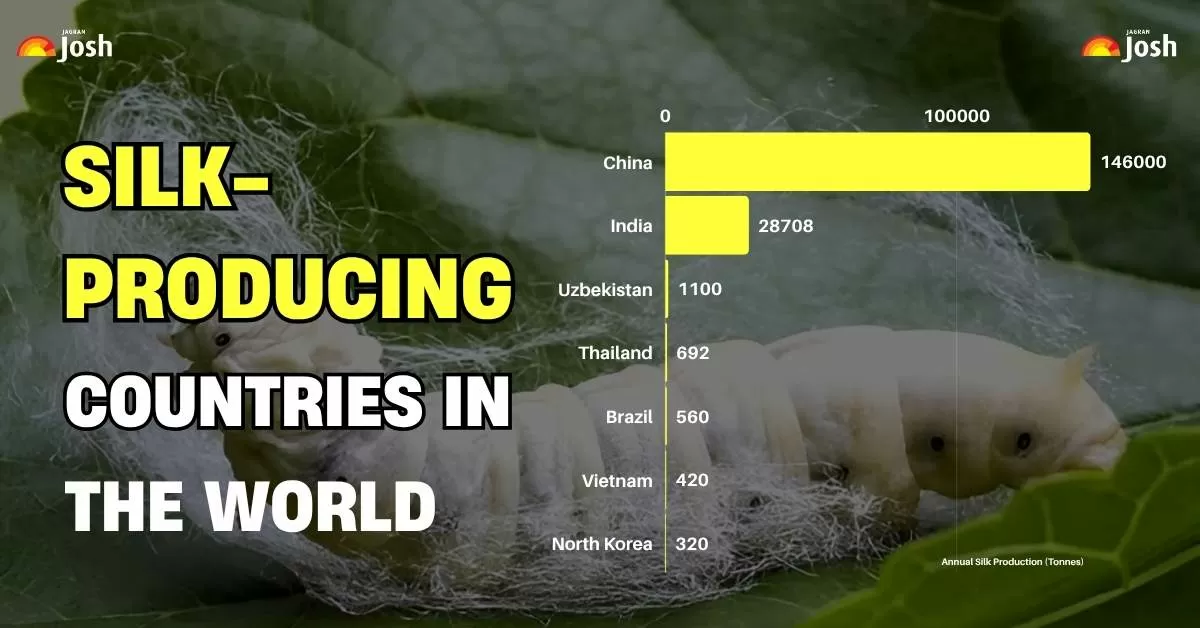You must have seen your grandmothers or mothers wearing Kanchipuram, Baluchari, Chanderi, Katan, or Kashmiri silk sarees. Silk sarees typically range in price from around ₹4,000 to lakhs.
Silk is a luxurious natural fibre known for its softness, lustre, strength, and durability. It's primarily composed of a protein called fibroin and is most commonly produced by the larvae of the silk moth, Bombyx mori. This process of cultivating silkworms for silk production is called sericulture.
Many countries around the world produce silk, including China, India, and Thailand. Silk production involves harvesting silkworm cocoons and extracting the fine threads to create luxurious fabrics.
According to the International Sericultural Commission, China is the largest producer of silk in the world, followed by India, Uzbekistan, Thailand and Brazil. The US, Italy, Japan, India, France, China, and the United Kingdom.
Check Out| Which Country Has the Longest Coastline in the World? List of the 7 Longest Coastlines in the World
List of Silk-Producing Countries in the World
According to the World Atlas, here are the top 7 largest silk producers in the world:
| Rank | Country | Silk Production (metric tonnes) |
| 1 | China | 146,000 |
| 2 | India | 28,708 |
| 3 | Uzbekistan | 1,100 |
| 4 | Thailand | 692 |
| 5 | Brazil | 560 |
| 6 | Vietnam | 420 |
| 7 | North Korea | 320 |
1. China
China is the largest silk producer and exporter from afar, producing about 80% of the world's silk (which is over 220,000 metric tonnes each year). The country is famous for its super-soft and bright mulberry silk, especially from areas such as Zhejiang and Jiangsu. China is a leader in traditional silk manufacturing and new and intelligent ways to cultivate silk sources. The old silk road was a great reason why Chinese silk became famous around the world.
2. India
India is the second-largest silk producer globally. Its silk industry is deeply connected to its culture; beautiful, unique silk types such as Banarasi and Muga are known for their artistic patterns. India is famous for making special silks such as Eri, Muga, Tasar, and even peace silk (where the silk insect is allowed to leave its cocoon). About 13% of the world's silk, or 35,000 MT, comes from India, with large production in Karnataka and West Bengal, supporting many rural families.
3. Uzbekistan
Uzbekistan, once an important stop on the Silk Road, is now a major silk producer in Central Asia, producing about 1,200 metric tonnes annually. They are known for their high-quality mulberry silk, made using a mixture of old techniques and modern agriculture. Its silk usually has vivid colours and sophisticated designs, popular in places like Russia and Germany.
Read On| Which is the Largest Rubber Producing State in India? List of Rubber-Producing States in India
4. Thailand
Thailand produces about 700 tonnes of silk each year. Its hand-based silk is loved for its detailed drawings and vibrant colours, especially the golden silk. In areas like Nakhon Ratchasima, silk creation is a family tradition. Thailand combines traditional methods with newer weaving technologies to remain a major participant in the silk world.
5. Brazil
Brazil is the biggest silk producer in the Western Hemisphere, making about 560 metric tonnes annually. Due to its warm climate, silk can be produced throughout the year, primarily in regions such as Paraná. Brazil emphasises sustainable silk production, meaning they endeavour to create silk in an environmentally friendly manner. This makes their silk popular in Europe and Asia.
6. Vietnam
Vietnam might not make as much silk as China or India, but its silk is known for its unique beauty and good quality. Silk weaving has been a part of Vietnamese culture for centuries, especially in Hà Nội. Their silk is often used in fashion and home decor, and they're working to keep their traditional weaving methods alive while reaching more global markets.
7. North Korea
It might be surprising, but North Korea also has a long-standing silk industry. While details are hard to come by due to its isolation, their silk is known for reasonable quality, and some of it makes its way into international markets. It's a small but important part of their exports.
9 Facts About Silk

Source: MAP Academy
- While it feels delicate, silk is incredibly strong. A silk thread of the same thickness is stronger than a steel wire. This strength has led to its use in surprising applications like parachutes and surgical sutures.
- Unlike synthetic fabrics made from chemicals, silk is a natural protein fibre, similar to wool. It's primarily composed of fibroin, with a "glue" called sericin holding the threads together in the cocoon.
- Silk has excellent thermal properties. It can keep you warm in cold weather and cool in hot weather, making it a comfortable fabric year-round.
- Silk is naturally hypoallergenic and smooth, which means it's less likely to irritate sensitive skin or cause allergic reactions compared to other fabrics.
- The unique triangular cross-section of silk fibres allows them to refract light at various angles, giving silk its characteristic natural sheen and smooth, soft feel.
- Silk can absorb a significant amount of moisture (up to 30% of its weight) without feeling damp. It also dries relatively quickly, which is practical for both wear and laundry.
- Despite its delicate appearance, silk is quite durable and can last for years with proper care.
- As a natural fibre, silk is biodegradable, meaning it can break down naturally by microorganisms in the environment, typically within 1-2 years if discarded.
- "Peace Silk" (Ahimsa Silk) is an ethical alternative that allows the silkworm to complete its life cycle and emerge from the cocoon naturally before the silk is harvested.
